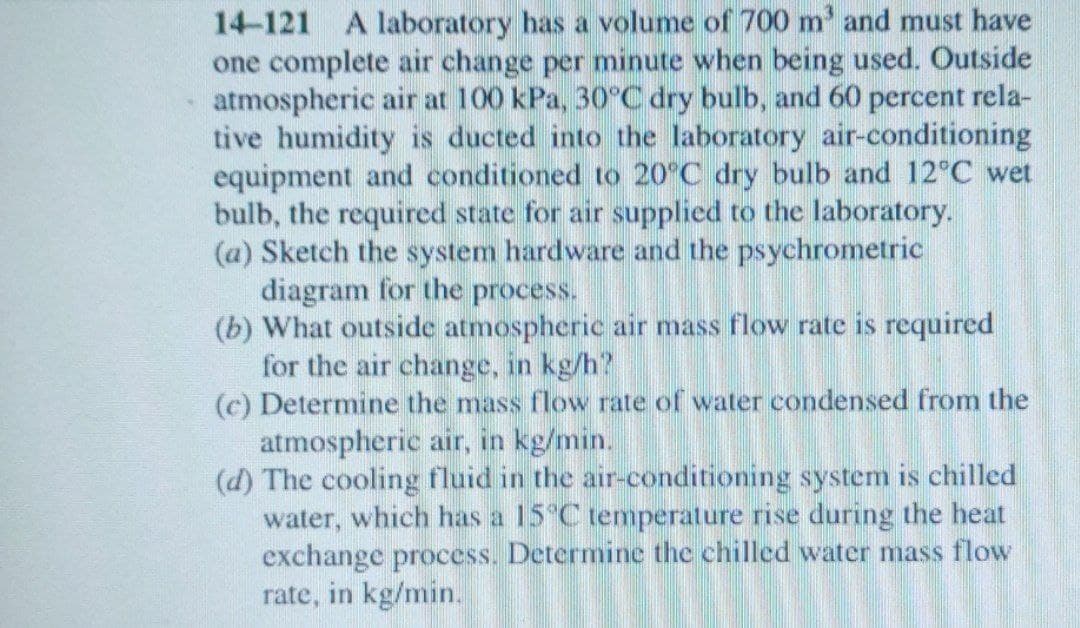14-121 A laboratory has a volume of 700 m' and must have one complete air change per minute when being used. Outside atmospheric air at 100 kPa, 30°C dry bulb, and 60 percent rela- tive humidity is ducted into the laboratory air-conditioning equipment and conditioned to 20°C dry bulb and 12°C wet bulb, the required state for air supplied to the laboratory. (a) Sketch the system hardware and the psychrometric diagram for the process. (b) What outside atmospheric air mass flow rate is required for the air change, in kg/h? (c) Determine the mass flow rate of water condensed from the atmospheric air, in kg/min. (d) The cooling fluid in the air-conditioning system is chilled water, which has a 15°C temperature rise during the heat exchange process. Determine the chilled water mass flow rate, in kg/min.
14-121 A laboratory has a volume of 700 m' and must have one complete air change per minute when being used. Outside atmospheric air at 100 kPa, 30°C dry bulb, and 60 percent rela- tive humidity is ducted into the laboratory air-conditioning equipment and conditioned to 20°C dry bulb and 12°C wet bulb, the required state for air supplied to the laboratory. (a) Sketch the system hardware and the psychrometric diagram for the process. (b) What outside atmospheric air mass flow rate is required for the air change, in kg/h? (c) Determine the mass flow rate of water condensed from the atmospheric air, in kg/min. (d) The cooling fluid in the air-conditioning system is chilled water, which has a 15°C temperature rise during the heat exchange process. Determine the chilled water mass flow rate, in kg/min.
Elements Of Electromagnetics
7th Edition
ISBN:9780190698614
Author:Sadiku, Matthew N. O.
Publisher:Sadiku, Matthew N. O.
ChapterMA: Math Assessment
Section: Chapter Questions
Problem 1.1MA
Related questions
Question

Transcribed Image Text:14-121 A laboratory has a volume of 700 m' and must have
one complete air change per minute when being used. Outside
atmospheric air at 100 kPa, 30°C dry bulb, and 60 percent rela-
tive humidity is ducted into the laboratory air-conditioning
equipment and conditioned to 20°C dry bulb and 12°C wet
bulb, the required state for air supplied to the laboratory.
(a) Sketch the system hardware and the psychrometric
diagram for the process.
(b) What outside atmospheric air mass flow rate is required
for the air change, in kg/h?
(c) Determine the mass flow rate of water condensed from the
atmospheric air, in kg/min.
(d) The cooling fluid in the air-conditioning system is chilled
water, which has a 15°C temperature rise during the heat
exchange process. Determine the chilled water mass flow
rate, in kg/min.
Expert Solution
This question has been solved!
Explore an expertly crafted, step-by-step solution for a thorough understanding of key concepts.
This is a popular solution!
Trending now
This is a popular solution!
Step by step
Solved in 3 steps with 3 images

Knowledge Booster
Learn more about
Need a deep-dive on the concept behind this application? Look no further. Learn more about this topic, mechanical-engineering and related others by exploring similar questions and additional content below.Recommended textbooks for you

Elements Of Electromagnetics
Mechanical Engineering
ISBN:
9780190698614
Author:
Sadiku, Matthew N. O.
Publisher:
Oxford University Press

Mechanics of Materials (10th Edition)
Mechanical Engineering
ISBN:
9780134319650
Author:
Russell C. Hibbeler
Publisher:
PEARSON

Thermodynamics: An Engineering Approach
Mechanical Engineering
ISBN:
9781259822674
Author:
Yunus A. Cengel Dr., Michael A. Boles
Publisher:
McGraw-Hill Education

Elements Of Electromagnetics
Mechanical Engineering
ISBN:
9780190698614
Author:
Sadiku, Matthew N. O.
Publisher:
Oxford University Press

Mechanics of Materials (10th Edition)
Mechanical Engineering
ISBN:
9780134319650
Author:
Russell C. Hibbeler
Publisher:
PEARSON

Thermodynamics: An Engineering Approach
Mechanical Engineering
ISBN:
9781259822674
Author:
Yunus A. Cengel Dr., Michael A. Boles
Publisher:
McGraw-Hill Education

Control Systems Engineering
Mechanical Engineering
ISBN:
9781118170519
Author:
Norman S. Nise
Publisher:
WILEY

Mechanics of Materials (MindTap Course List)
Mechanical Engineering
ISBN:
9781337093347
Author:
Barry J. Goodno, James M. Gere
Publisher:
Cengage Learning

Engineering Mechanics: Statics
Mechanical Engineering
ISBN:
9781118807330
Author:
James L. Meriam, L. G. Kraige, J. N. Bolton
Publisher:
WILEY